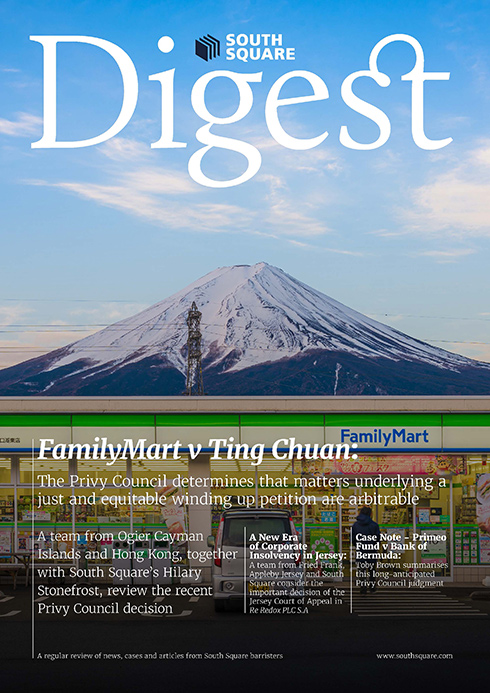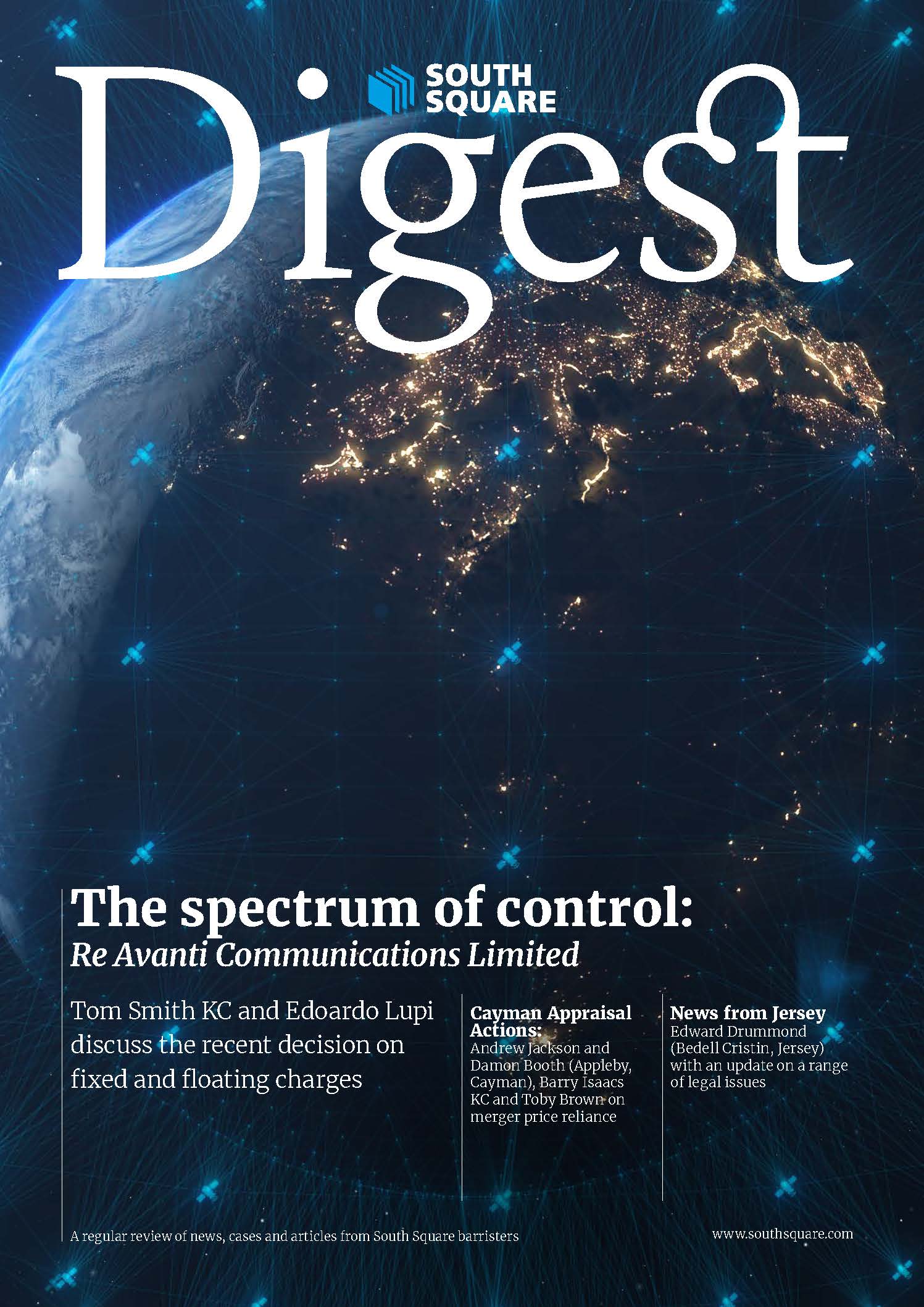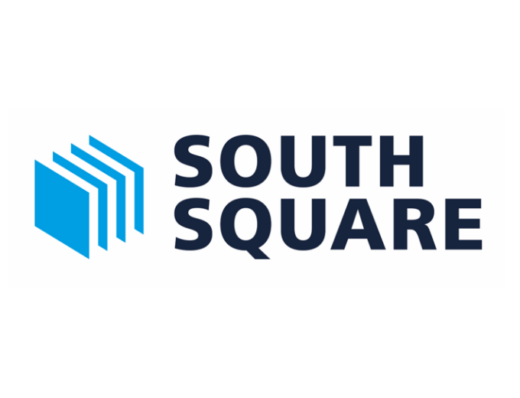

BY Andrew Jackson (Appleby), Damon Booth (Appleby), Barry Isaacs KC and Toby Brown
Introduction
In recent years, much use has been made of the regime which the Cayman Islands’ Companies Act provides to facilitate corporate mergers. Often the purpose of the merger is to cash out minority shareholders, commonly to enable a publicly-listed company to be taken private. Where minority shareholders are faced with that prospect, section 238 of the Act entitles them to dissent from the merger and to pursue proceedings (an “appraisal action”) to have the fair value of their shares determined and awarded by the Court.
There have been a large number of cases where minority shareholders have considered the price offered for their shares (the “merger price”) to be materially unfair, and where the Cayman courts have dealt with appraisal actions. Seven have proceeded to trial on the question of fair value,1 appeals against two fair value orders have been decided by the Cayman Islands Court of Appeal (“CICA”),2 and one has been the subject of a further decision of the Privy Council.3
In some of these cases the Court has been invited to place reliance on the merger price (also known as the “transaction price”) either as a measure of fair value, or as a cross-check against other valuation methods. This article examines the bases on which the merger price has either been given weight in the determination of fair value or held to be unreliable. We start by providing a brief overview of the approach to evidencing fair value, including the question of the burden of proof. We then analyse four decisions where the merger price was relied upon, starting with Re Nord Anglia Education Inc (unrep. 17 March 2020) and Re FGL Holdings (unrep. 20 September 2022), before moving to the recent judgments Re Trina Solar Limited (unrep. 4 May 2023), and Re iKang Healthcare Group (unrep. 21 June 2023).
Evidencing fair value
In the CICA’s judgment in Trina Solar, Birt JA cited with approval Segal J’s two-fold exposition at first instance of the meaning of “fair value”.4 First, the Court is seeking to assess the monetary amount which in the circumstances represents its best estimate of “the true worth of the dissenting shareholders’ shares (true worth meaning the actual value to the shareholder of the financial benefits derived and available to him from his shares and by being a shareholder)”. Second, the reference to “fair” requires that the method of assessment is fair to the dissenting shareholder by “ensuring that all relevant facts and matters are considered and that the sums selected properly reflects the true monetary worth to the shareholder of what he has lost, undistorted by the limitations and flaws of particular valuation methodologies and fairly balancing, where appropriate, the competing, reasonably reliable alternative approaches to valuation relied on by the parties”.
As this dicta highlights, parties to appraisal proceedings often advance different methodologies to establish the fair value of the shares at the relevant valuation date. In addition to the merger price, these are principally: (a) adjusted trading or market price, (b) comparable companies’ analysis, and (c) discounted cashflow forecast (“DCF”) valuation. Recent case law has confirmed methodologies can be “blended”, by applying a percentage weighting to two or more of the valuations to produce a composite sum that reflects the fair value.
As Parker J stated in FGL Holdings at [269], Cayman law creates no presumption as to which methodology will be suitable in any particular appraisal. Accordingly, contested proceedings involve the parties adducing complex and competing expert valuation evidence. In analysing the expert (and factual) evidence, the Court is required to apply the principle that each party bears the burden of proving its case on fair value. As Segal J recently explained in iKang Healthcare at [36]:
“The Court will consider detailed expert valuation evidence in making its determination of fair value. In assessing such expert evidence, as I explained in Re Shanda Games at [84] (unrep. 25 April 2017) (Shanda GC) “…the Court should approach the disputed issues on the basis that it is for [the Company] and the Dissenting Shareholders to establish, on the balance of probabilities, that the valuations their experts have presented on the issue in question are reasonable and reliable. If only one is reasonable and reliable then the Court should (absent some other reason for not doing so) follow and apply that approach. If both appear to be reasonable and reliable, the Court must decide which is to be preferred. If neither is reasonable and reliable, the Court must make its own determination. The Court, in a petition under section 238, is not able simply to treat fair value as not being established…” (emphasis added).
In the same judgment, Segal J made clear that this approach extends well beyond asking whether an expert has, on the factual evidence available, essentially done the maths correctly: the reasonableness and reliability of any valuation will largely depend on the availability of the factual evidence on which it needs to be based. At [35], the Judge added:
“Where a company contends that the merger consideration is indicative of fair value sufficient evidence of “market efficiency, fair play, low barriers to entry, outreach to all logical buyers and a well-designed sales process” must be adduced (see Trina at [156]). Where relevant documentary or witness evidence is not available, the Company “risks failing to satisfy the evidential burden” in respect of that aspect of its case on fair value” (see Trina at [156]). Where a company contends that the market trading price is indicative of fair value, it needs to demonstrate both that there was no material non-public information and that the market for the relevant shares at the relevant time was semi-strong efficient (see Trina at [128]).”
Re Nord Anglia Education Inc.
Nord Anglia was the first case in which substantial reliance was placed on the merger price in the determination of fair value, with the Court giving it a 60% weighting, and the remaining 40% given to a DCF analysis.
The company contended that the merger price was the product of a genuinely arm’s length and fair process which generated the highest price available in the market. This position was challenged by dissenting minority shareholders inter alia on the bases that investment funds managed by Baring Private Equity Asia were on both sides of the transaction and that the sale process had been designed to dissuade interested third parties from participating.
Kawaley J referred to the Delaware Supreme Court’s decision in Dell lnc v. Magnetar Global Event Driven Master Fund Limited 177A.3d I (2017) (“Dell”), where Valihura J warned that in cases where there has been “a robust sale process involving willing buyers with thorough information and the time to make a bid…the Court of Chancery should be chary about imposing the hazards that always come when a law-trained judge is forced to make a point estimate of fair value based on widely divergent partisan expert testimony.” (emphasis added).
On the facts, Kawaley J considered that there had been an arm’s length transaction but that it was not robust in the sense described in Dell. Nonetheless the Judge decided that reliance could be placed upon the merger price. He observed that Baring had a fiduciary duty to the beneficial owners of the selling funds to maximise the sale price (and it is implicit that no breach of fiduciary duty had been established).5 The Judge was also satisfied that there was no significant overlap of beneficial interests in the funds on each side of the transaction, and that the potential conflict of interest by virtue of Baring being on both sides of the transaction had been addressed through the establishment of a special committee of the company’s board of directors. The Judge further observed that the merger price had been approved by that special committee based on credible independent financial advice, and was higher than any price at which the shares had traded in the preceding year. Turning to the robustness of the sale process, the Judge found that there was at least some attempt to find other bidders and none came forward in a serious way, and he considered that there was no credible evidence that any seriously interested bidders willing to pay a substantially higher price had been rebuffed (including because a dissenter which had been a longstanding shareholder of the company had declined to make a topping bid).
The Court did, however, refer to numerous factors which might have been taken to undermine the reliability of the merger price as a measure of fair value. These included that the selling funds were under the control of a Baring entity which held sufficient voting power to approve the merger on its own and which had already agreed to sell to the affiliated bidder. The Baring-owned controlling shareholder had also obtained a “force the vote” clause in the merger agreement, entitling it to require an extraordinary general meeting to vote on the proposed merger even if the board changed its recommendation regarding the merger, save in very limited circumstances. The buying side also had unlimited matching rights under the merger agreement, and were thus entitled repeatedly to outbid any other superior bidder for the company; the largest single investor on the buying side was admittedly a client of Baring; and Baring personnel who generally worked as part of the same team were on both sides of the negotiating table. The go-shop period, throughout which the fairness advisor was expected to solicit third-party interest in acquiring the company, was also limited to a brief 30 days, and the go-shop mechanism made it difficult for competing bids to be made. The Court further recognised that any potential third-party bidder would have been at an informational disadvantage to the buying side.
Kawaley J ultimately acknowledged that a number of those factors might have discouraged potential third-party bidders, but considered that any seriously interested party would nonetheless have come forward, thus disregarding the potential effect of the winner’s curse. Treating the merger price as the starting point, as already stated, the Judge decided to give it more weight at 60%, against 40% for the DCF valuation advanced by one of the experts.
Nord Anglia was cited by the CICA in Trina Solar without apparent criticism. However, in light of their judgment as to the importance of a robust sales process to justify reliance on the merger price, and the decision in iKang (both discussed below), we question whether a case on similar facts would now be decided in the same way.
Re FGL Holdings
In Re FGL Holdings the Court determined that the merger price equated to the fair value of the shares, and thus declined to give weight to other valuation methodologies put forward in the expert evidence.6 Notably, however, the facts of that case were strikingly different from almost all other appraisal actions which have been commenced in the Cayman courts to date, which typically arise from take-private transactions driven by a controlling shareholder which can approve the merger on its own and is a member of the buyer group acquiring the business.
FGL was a US insurance company which was the subject of an unsolicited bid by another US insurance business (called FNF) which had been one of its minority shareholders (with 17% voting power) for the few years preceding the transaction.
Parker J acknowledged that fair value and merger price are not the same. Nonetheless, he held (in effect echoing the dicta in Dell cited above) that merger price can be evidence of fair value “where the transaction process was properly conducted so as to ensure that the market was adequately tested and there is sufficient evidence that market conditions were such as to facilitate an arm’s length transaction with all potentially interested parties”.7 Furthermore, applying Segal J’s dicta at first instance in Trina Solar, he cited the need for sufficient evidence of “‘market efficiency, fair play, low barriers to entry, outreach to all logical buyers’ and a well-designed sales process”. The Judge added that the precise weight to be given to the merger price depended upon the assessment of the process and whether it achieved these objectives, as well as the reliability of other methods.
On the evidence, Parker J concluded that the merger price provided a sound indicator of fair value because the sales process was well designed, at arm’s length and represented a transaction between a willing buyer and seller.
More specifically, the proposed merger was not a management or controlling shareholder buyout (FNF having been incapable of forcing it through on its own), and it received an overwhelming level of shareholder approval, by more than 99% of the shareholders unaffiliated with FNF which were present and voting (being 78% of all unaffiliated shareholders). In addition, the company’s co-chairman, who led negotiations on behalf of the special committee, was best placed to pursue the best price that could be obtained, and his interests were substantially aligned with those of the unaffiliated minority shareholders by virtue of the relatively substantial minority shareholding in FGL which he too would be selling in the transaction. Furthermore, FNF had confirmed that it was also willing to sell its minority shareholding in the company if a superior bid emerged, and the go-shop process was sufficiently open, notwithstanding that only one potential acquirer (a competitor of the company) came forward, and entered into an NDA and then failed to put forward any credible indicative bid.
In addition to those facts relating to the merger process itself, it is apparent from the judgment that little effort was made to quantify the value of the synergies arising from the transaction, which would in principle fall to be excluded from an award of fair value.8 Had there been engagement with that issue, the Court may well have concluded that the merger consideration actually somewhat exceeded the fair value of the shares. Furthermore, no reliable income-based valuation was put before the Court, and the market trading price had also been rendered wholly unreliable because of the impact of the COVID-19 pandemic on the market at the relevant time,9 so the Court was unable to weigh either of those possible indicators of fair value in the balance.
The decision in FGL Holdings to rely entirely on the merger price to ascertain fair value remains unusual, though it is an unsurprising conclusion on the facts.
Re Trina Solar Limited (CICA)
In Trina Solar, when determining fair value at first instance, Segal J had given the merger price a 45% weighting, with 30% being given to the adjusted trading price of the shares, and 25% to a DCF valuation. The dissenting shareholders appealed against various aspects of the first instance determination, including the decision to place any weight on the merger price, a position which the CICA ultimately accepted.
In the CICA’s judgment at [139], Birt JA (with whom Beatson and Field JJA agreed) cited with approval the summary by the Delaware Court of Chancery in Re Solera Holdings Inc of the features which ordinarily justify reliance on the merger price:10
“…deal price is “the best evidence of fair value” when there was an “open process,” meaning that the process is characterised by “objective indicia of reliability.” Such “indicia” include but, consistent with the mandate of the appraisal statute to consider “all relevant factors,” are not limited to:
- “[R]obust public information,” comprised of the stock price of a company with “a deep base of public shareholders, and highly active trading,” and the views of “equity analysts, equity buyers, debt analysts, debt providers and others.”
- “[E]asy access to deeper, non-public information” where there is no discrimination between potential buyers and cooperation from management helps address any information asymmetries between potential buyers.
- “[M]any parties with an incentive to make a profit had a chance to bid,” meaning that there was a “robust market check” with “outreach to all logical buyers” and a go-shop characterised by “low barriers to entry” such that there is a realistic possibility of a topping bid.
- [A] special committee “composed of independent, experienced directors and armed with that (sic) power to say ‘no’ , ” which is advised by competent legal and financial advisors.
However, Birt JA rejected the submission that no or minimal weight must be given to a merger price which is the product of a process which failed to exhibit all such features. He explained (agreeing with the trial Judge) that: “The mere fact that there are flaws in the deal process does not of itself mean that the merger price cannot be given weight. It all depends on the gravity and nature of the flaws, although clearly the existence of any flaws raises a serious issue as to whether weight can still be placed on the merger price.”11
As already noted, the CICA cited the decision in Nord Anglia as an example of a sale process, although at arm’s length, which was not as robust as it might have been but where the merger price still provided a reasonable indicator of fair value. In contrast, if the breaches are substantial, the merger price is unlikely to be a reliable indicator of fair value, and accordingly little or no weight should be given to it.
On the facts, the gravity, nature and indeed the number of the flaws in the Trina Solar merger process were significant. The CICA held that it was not reasonably open to the trial Judge to give any weight to the merger price in the determination of fair value, including in light of the defects which the Judge himself had found in the merger process.12 Birt JA referred to various aspects in the merger process which undermined the Judge’s conclusion, including that:
- The company failed to provide a witness who could explain the actions of the special committee. The committee member who gave evidence at trial had been an unsatisfactory witness, for example, he could not explain satisfactorily why the committee had positively decided to exclude the company’s four largest main competitors from the market check.
- Very few documents in relation to the sale process were available, with significant gaps in the information needed to explain the actions of the special committee, for example as to their selection of potential bidders for the market check or why the company’s main competitors were not included.
- There were serious defects in the market check carried out by the special committee. Although the Judge did not conclude that the committee’s exclusion of the company’s major competitors was deliberate, Birt JA stated that it was the “effect of the decision…which is important …[which] would be to reduce the chances of an alternative bid. The Special Committee clearly failed the requirement in Dell (as adopted by the judge) that there be ‘outreach to all logical buyers’”.13
- The company failed to put the various potential bidders in touch with each other, despite a specific request from one potential bidder interested in forming a consortium. This had the effect of reducing the chances of a competing bid. In addition, the NDA was so tight it prevented any interested party from making a bid unless invited to do so by the special committee.
- The Judge had accepted that the influence and position of the chairman in having dual roles in both the company and the buyer group created a material risk that the merger process would fail to produce an independent competing bid. Birt JA stated that the important point was this material risk existed, which was not addressed by the special committee, and was clearly relevant to whether weight could be placed on the merger price.
- The connections between the special committee members and the chairman raised concerns about their independence. Referring to the dicta from Solera quoted above, Birt JA said that “it is an important indicia of reliability that a special committee be composed of independent experienced directors”. On the Judge’s own findings there were concerns about this aspect.
- Finally, Birt JA considered the dissenting shareholders’ criticisms of the fairness opinion on which the special committee had relied. He observed that the fairness advisor had, without explanation, taken a cost of debt figure of 13%, which was very high when compared to the two experts’ figures of 4.9% and 5.5%. Had the fairness advisor used a figure of 4.9% this would have yielded a valuation that was more than double the merger price. This was therefore a significant error. Birt JA concluded it was another matter which questioned the reliability of using the merger price, given the likelihood of some shareholders voting differently if the fairness opinion had reflected a justifiable cost of debt figure and therefore produced a DCF valuation well in excess of the merger price.
The CICA criticised the Judge for effectively shifting the burden on to the dissenting shareholders, contrary to the principles summarised at the start of this article. In particular:
- On the fairness opinion, it was the company that was seeking to rely upon the opinion to support the merger price as indicating fair value. It therefore had the burden of producing any necessary evidence in support of the fairness opinion.
- On the documentary evidence to explain the actions of the special committee, the correct target for criticism and for the potential drawing of adverse inferences was the company, not the dissenting shareholders.
- On the market check carried out by the special committee, it was for the company to show that this was adequate to ensure all potential bidders had been approached, but the Judge had in effect placed the burden on the dissenting shareholders to show that potential bidders were prevented from coming forward.
Given the preponderance of factors which demonstrated the unreliability of the merger price, Birt JA held that no reliance at all could safely be placed on the merger price. It bears noting that this was a case where the merger had been approved by 97.8% of the shares voted or deemed to have been voted in favour.
Having made clear that “heightened scrutiny” is required where the merger transaction is effectively a management buyout, Birt JA concluded by emphasising the protections developed in Delaware jurisprudence and adopted in the Cayman Islands to provide comfort that the merger price can be probative of fair value.14 The importance of this point was underscored by his warning that “if despite the deficiencies identified and the failure of the Company to engage properly in the process by producing suitable evidence in the form of witnesses and documents, weight can still be placed on the Merger Price, there is a substantial risk that companies in future will behave in a similar manner and not be open and transparent about all relevant evidence”.
Re iKang Healthcare
The judgment in Re iKang Healthcare was delivered shortly after the judgment in the Trina Solar appeal. This was not a case in which either expert contended that the Court should give weight to the merger price, but the company’s expert sought to put it forward as a cross-check for the valuation methodologies on which he did rely, effectively inviting the Court to regard it as a ceiling on fair value. Segal J rejected that proposition, finding that the merger price did not assist in reaching a fair value determination in this case.
The Judge did not accept the company’s argument that the merger price was insufficiently reliable to be given any independent weight in the fair value determination, but was sufficiently reliable to be considered when deciding between other competing valuations and determining fair value in light of them. Fundamentally, if the merger price could not properly be given weight in determining fair value, then neither could it serve as a useful cross-check of other valuations.
In any event, the Judge preferred the dissenting shareholders’ expert evidence on this issue, finding inter alia that the chairman’s ability to veto any competing transaction, together with his significant informational advantage, created a fundamental (and structural) difficulty for the merger process. In particular, the market checks and the process as a whole were limited. Further, the chairman showed no signs that he was prepared to “release his grip on [the Company]”,15 and thus there was never a realistic prospect of an outright buyer being found, such that the exercise was confined to seeking out new partners for the chairman (and his syndicate). Moreover, a poison pill Rights Agreement which had been implemented reinforced management’s and the chairman’s control over the merger process. The Judge considered that those circumstances had “a substantial chilling and complicating effect that reduced the pool of interested parties”,16 gave ultimate control of the process to the chairman, and resulted in a price (paid by his new partners) that was likely to be below what would be paid by an arm’s length buyer in a competitive bidding process.
Having reminded himself of the evidential burden, Segal J held that the company had failed, without adequate explanation, to secure and produce important documentary evidence from its special committee’s fairness advisor regarding its work in relation to the market check process. This further weakened its case for (indirect) reliance on the merger price in determining fair value. The Judge proceeded to warn at [474] that:
“in future cases companies in section 238 proceedings should be prepared to make available a proper documentary record relating to the work of financial advisers to a special committee and as to the conduct of a market-check and sales process and need properly to justify why documents have not been retained or are not available.”
Conclusion
The CICA in Trina Solar and the Grand Court in iKang Healthcare have reaffirmed the principle as to the burden of proof in Cayman appraisal actions, and the evidence which companies involved in such actions will need to adduce where they seek to contend that reliance should be placed upon the merger price as an indicator of fair value.
The CICA’s decision in Trina Solar is also notable for emphasising the principles from the Delaware jurisprudence relating to a robust sales process, both to justify weight being placed on the merger price, and to prevent abuse of the statutory merger regime, not least where it is being used to facilitate management or controlling shareholder buyouts.
These judgments should focus the minds of those involved in such merger processes, since it is likely that companies involved in appraisal actions will need to take more of an “open book” approach to documentary disclosure and proffering witness evidence in respect of the process which led to the relevant merger, in addition to that which may have a bearing on any other appropriate valuation methodology.
Barry Isaacs KC appeared in Re iKang Healthcare, instructed by Andrew Jackson and colleagues from Appleby. Both acted for different groups of dissenting shareholders in Re Nord Anglia.
1These are Re Integra Group [2016] 1 CILR 192, Re Shanda Games Ltd (unrep. 25 April 2017), Re Qunar Cayman Islands Ltd [2019] 1 CILR 611, Re Nord Anglia Education Inc (unrep. 17 March 2020), Re Trina Solar Limited (unrep. 23 September 2020), Re FGL Holdings (unrep. 20 September 2022) and Re iKang Healthcare Group (unrep. 21 June 2023)
2Re Shanda Games Ltd [2018] 1 CILR 352 and Re Trina Solar Limited (unrep. 4 May 2023)
3Re Shanda Games Ltd [2020] UKPC 2
4Segal J at first instance [91]; Birt JA on appeal at [34]
5Although note that an appraisal action is concerned only with the issues of fair value and a fair rate of interest, not claims for breaches of fiduciary or any other duty, which a minority shareholder that has dissented from a merger will have lost the right to pursue derivatively on behalf of the company
6Although it is possible that weight may have been given to an appropriate income-based valuation methodology, if one had been adduced. The dissenting shareholders’ expert in that case had produced a dividend discount model, which the Court held was unreliable for valuing an insurance business such as FGL.
7See at [570]-[571].
8Since fair value does not include any value particularly arising from the accomplishment or expectation of the merger
9Notwithstanding that the Court found that the market for the company’s shares was informationally efficient, and that there was no material non-public information
10[2018] WL 3625644 (30 July 2018), at p.17 per Bouchard C
11See at [136], [142]
12See at [146]
13See at [146(iv)(a)]
14See at [140] and [148]
15See at [451]
16See at [470]










![Brake & Anor v The Chedington Court Estate Ltd [2023] UKSC 29](https://southsquare.com/wp-content/uploads/2024/02/Brake-Anor-scaled-e1728649908896.jpeg)









